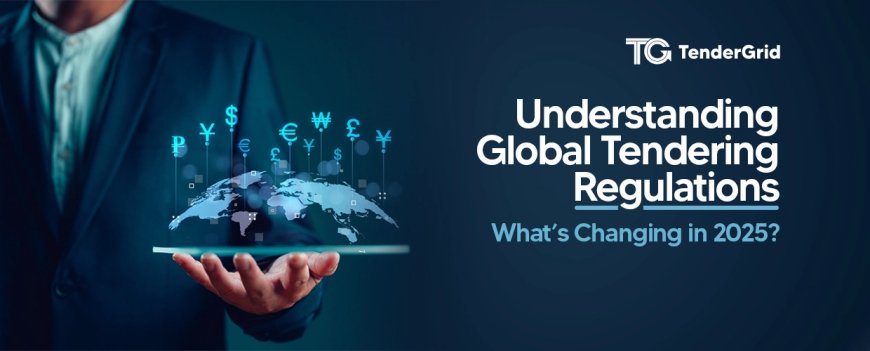Understanding Global Tendering Regulations: What’s Changing in 2025?

As we approach 2025, we can observe that the Global Tendering Process is experiencing revolutionary changes. With the emergence of sustainability imperatives, digital innovations, and geopolitical shifts, procurement frameworks are being reorganized to address contemporary challenges. For companies involved in Global Tenders and Government Tenders, keeping pace with changing regulations is not only advisable—it's imperative.
This article discusses the most important modifications in Global Tendering Regulations in 2025 and how suppliers, particularly SMEs, can navigate this ever-changing landscape.
1. The Rise of Sustainability in Tendering
Sustainability is currently an essential part of global public procurement. Governments are incorporating Environmental, Social, and Governance (ESG) considerations into bidding and evaluation frameworks to advance green innovation and responsible sourcing.
-
Ireland has enacted the Green Public Procurement Strategy (2024–2027), which mandates as much as 10% of the weight on tender evaluation based on ESG indicators.
-
The UK requires at least 10% ESG weight in evaluation under Government Tenders over £123,000.
-
European Union policy encourages member states to incorporate environmental performance criteria in all major procurements.
This ESG focus is indicative of wider Global Tendering Trends, where sustainability is a regulatory requirement rather than a choice.
2. Localisation and SME Empowerment
Countries are reassessing the openness of their Government Tendering markets to empower domestic industries:
-
India has reinforced its “Make in India” strategy by banning Global Tenders for government procurements up to ₹200 crore (~USD 24 million).
-
Indonesia and Vietnam have introduced minimum local content requirements.
-
South Africa maintains a strong preference points system for Black Economic Empowerment (BEE)-compliant companies.
These shifts create new opportunities for local suppliers while reshaping the Global Tendering Process.
3. Digitalization of Procurement Processes
Digital transformation is a hallmark characteristic of the 2025 Global Tendering Environment:
-
Procurement Platforms: Nations such as Brazil, Kenya, and the Philippines are implementing new centralized systems.
-
Blockchain: The EU and others are testing blockchain-based procurement to enhance transparency.
-
AI: Artificial Intelligence is making Global Tenders' evaluation easier, and more accurate, and highlighting compliance issues.
To remain competitive, platforms such as Tender Grid are now becoming a necessity for companies to search, monitor, and respond to Global Tenders and Government Tenders in real time.
4. Regulatory Harmonization Through Trade Agreements
Several trade agreements are aiming to harmonize procurement rules, improving access for cross-border suppliers:
-
CPTPP mandates fair and transparent procedures among its 11 members.
-
WTO GPA is being adopted by more countries, including Brazil and South Africa, to provide mutual market access.
As Global Tendering Trends evolve, such harmonization encourages a predictable environment for international suppliers, enhancing participation in Global Tenders.
5. Mandatory ESG Disclosures and Compliance
Environmental and social transparency is now a non-negotiable part of the Global Tendering Process:
-
Climate Risk Reporting: Infrastructure and energy bidders must disclose emissions and resilience plans.
-
Social Responsibility: Human rights, labour conditions, and diversity policies are critical evaluation factors.
These mandates align closely with how platforms like Tender Grid assess supplier profiles, helping contractors match with ESG-compliant Government Tenders and donor-funded Global Tenders.
Key Global Changes in Tendering Regulations (2025)
|
Country/Region |
New Regulation (2025) |
Impact on Bidders |
|
India |
Ban on Global Tenders up to ₹200 crore |
Increased access for Indian SMEs |
|
United Kingdom |
Minimum 10% ESG weight in contracts > £123,000 |
Greater emphasis on sustainability |
|
European Union |
Green procurement policies mandated across member states |
Environmental metrics matter in evaluations |
|
Brazil |
Enhanced ComprasNet 4.0 platform |
Digitized access to federal Government Tenders |
|
South Africa |
Strengthened BEE compliance for public contracts |
Inclusivity drives selection criteria |
|
Australia |
National Sustainable Procurement Policy introduced |
ESG focus expanded to small business procurement |
|
ASEAN (Vietnam) |
New local content mandates for public projects |
Encouragement for JV bids with local firms |
|
World Bank / ADB |
New ESG risk frameworks for funded Global Tenders |
Detailed disclosures now mandatory |
Challenges for Bidders in 2025
These regulatory changes present both opportunities and obstacles in the Global Tendering Process:
-
Documentation Overload: Greater ESG and digital documentation demands increase bid preparation time.
-
Tech Adoption: SMEs need to digitize processes quickly to remain competitive.
-
Higher Competition: As more companies use tools like Tender Grid to access tenders, the bar for success is rising.
However, for businesses that proactively adapt to Global Tendering Trends, these challenges become a strategic edge.
What Should Businesses Do Now?
To remain competitive in 2025's Global Tendering Environment, businesses should:
-
Implement ESG Standards: Adopt transparent sustainability practices that align with current regulations.
-
Digitize: Use e-signatures, electronic documentation, and register on portals like Tender Grid to increase reach.
-
Build Internal Capacity: Train teams in bid writing, ESG reporting, and e-tender compliance.
-
Partner Locally: In countries with local preference policies, form joint ventures with domestic suppliers.
-
Track Trends: Stay updated with the latest Global Tendering Trends to anticipate new opportunities.
Conclusion
The 2025 Global Tendering Process is a wider change in public procurement driven by sustainability, digital modernization, and economic inclusiveness. For companies, particularly SMEs and mid-level suppliers, compliance with these Global Tendering Trends is not negotiable—it's a matter of survival and expansion.
Platforms such as Tender Grid play a critical role in this evolution, assisting suppliers from various industries to find, handle, and win Global Tenders and Government Tenders with real-time insights, notifications, and assistance.
In this fast-changing regulatory environment, information is power—and flexibility is the greatest competitive edge.
What's Your Reaction?
































































